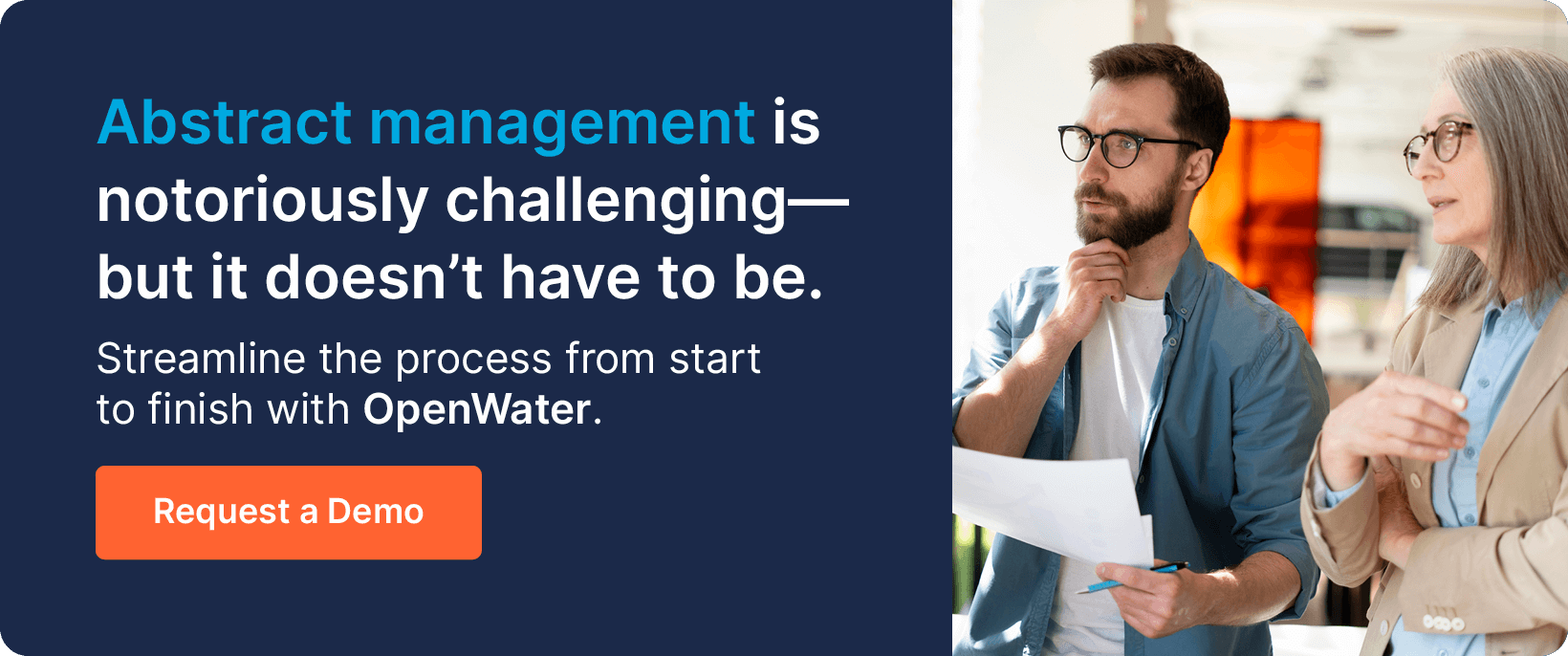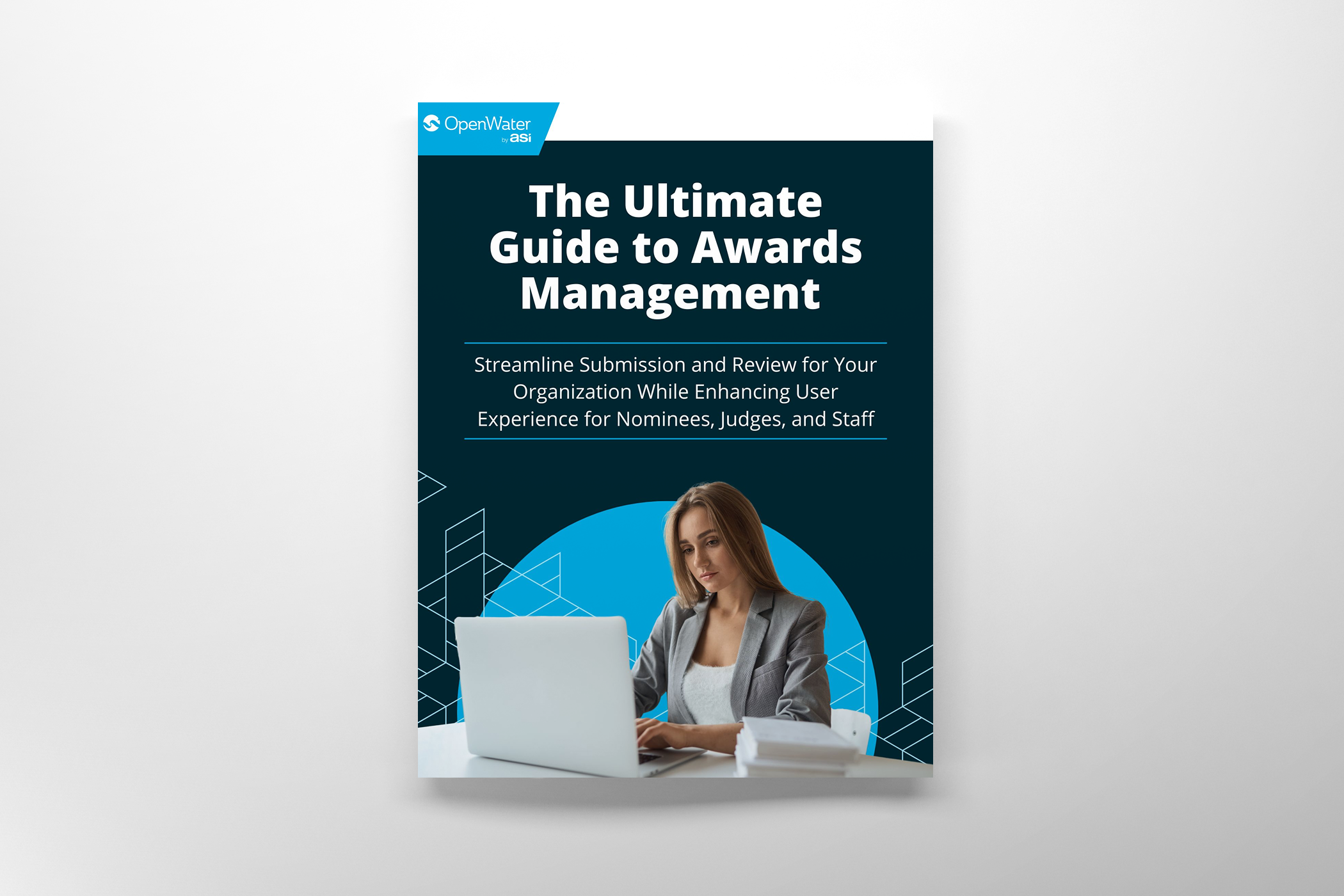
What Is Abstract Management? A Guide for Conference Planners
If you’ve ever planned a conference or similar event for your association or higher education institution, you know how important abstracts are for efficient organization. These short descriptions of proposed presentations allow you to create your speaker list, build sessions that flow logically, and help attendees find offerings that appeal to them.
Managing abstracts is essential to planning a successful event, but if you’re new to the process, you might feel overwhelmed or uncertain about where to start. Fortunately, you’ve come to the right place! This guide will cover everything you need to know about abstract management, including:
- Abstract Management FAQ
- Steps of the Abstract Management Process
- How Software Can Help With Abstract Management
Before we discuss how to set up a streamlined abstract management process that benefits everyone involved in your organization’s conferences, let’s examine why doing so is important for effective events.

Abstract Management: Frequently Asked Questions
To help you get your bearings on this often-complex topic, we’ve answered a few of the most common questions about abstract management below.
What is abstract management?
Abstract management encompasses all tasks associated with collecting, reviewing, making decisions on, communicating about, and organizing proposals for presentations at conferences or other similar events. As previously mentioned, the term “abstract” in this context refers to a short description of one of these presentations, usually covering the research the speaker has conducted and the conclusions they plan to discuss in their session.
Abstract management will look slightly different depending on your event’s length, format, and audience (e.g., abstract submissions from faculty and undergraduate students at a university will likely involve different review approaches and expectations). So, while we’ll discuss general best practices in this guide, keep in mind that you’ll likely need to adapt your approach slightly for each event your organization hosts.
Why is abstract management important?
Streamlined abstract management systems benefit everyone at your organization involved in conference planning and execution, as well as all event speakers and attendees. These are just a few of the advantages your association or higher ed institution can experience:
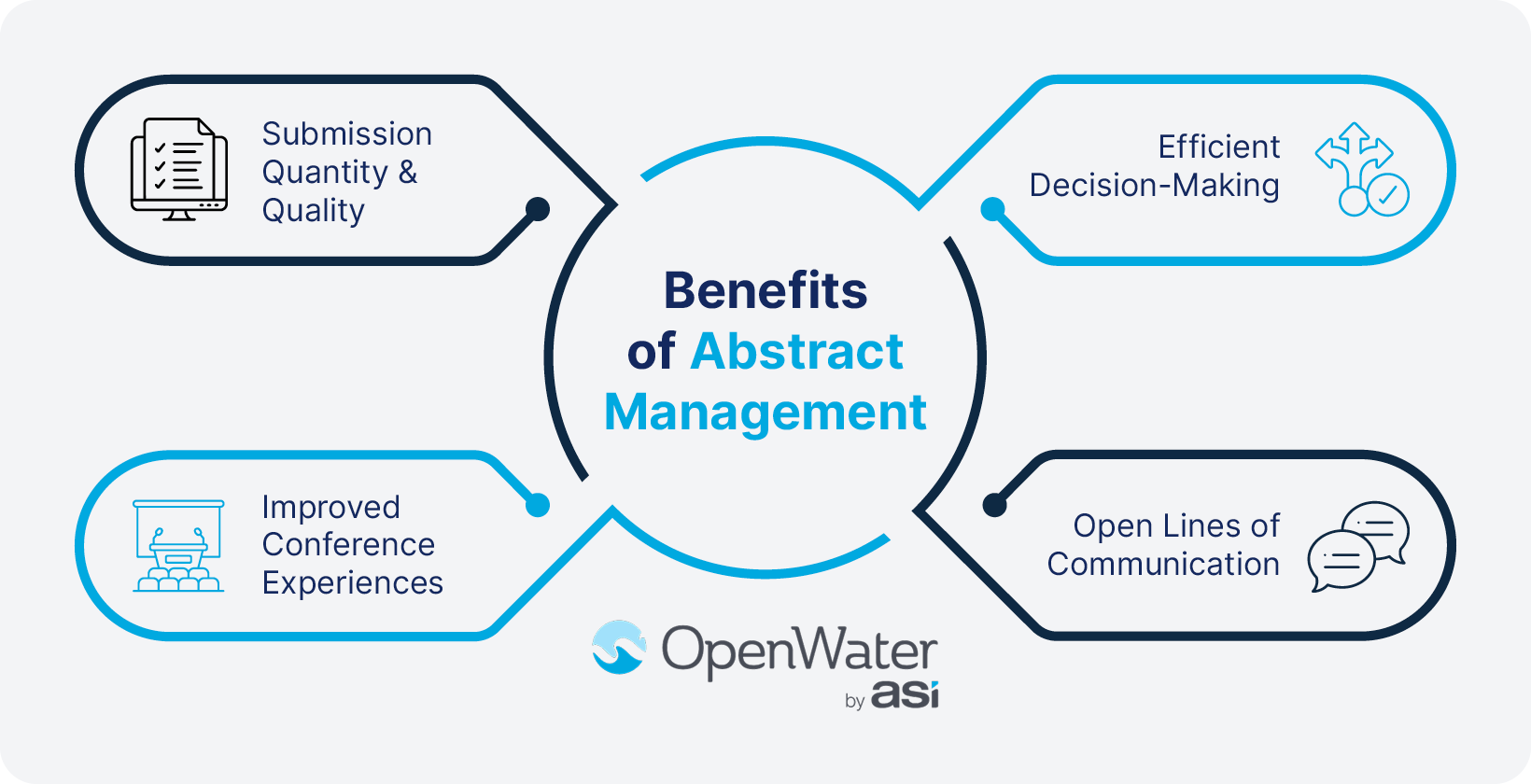
- Higher quantity and quality of submissions. When your abstract collection portal looks professional and is easy to use, more potential speakers are likely to submit proposals for consideration. Plus, sharing clear expectations tends to result in better abstracts.
- More efficient decision-making. Understanding expectations is also useful for reviewers since they’ll know what to look for as they judge submissions. Then, if they can review all of their assigned abstracts in one place, your organization can turn around responses faster.
- Open lines of communication. In addition to providing centralized criteria, a structured abstract management system allows you to communicate more effectively with applicants and team members, keeping everyone informed at all times.
- Improved conference experiences. Ultimately, well-managed abstracts lay the foundation for a smoothly run conference where participants can easily find the sessions they want to attend and gain value from the event. Speakers will also have a better idea of how they need to prepare before the event and therefore a better time presenting at it.
Event planning is often stressful and highly involved, but effective abstract management can make a big piece of the puzzle easier. There is a learning curve, but the more conferences you use your abstract management system for, the better your team will get at the process.
What are some common pain points of abstract management?
Abstract management is notoriously difficult within association and higher education circles, but most challenges arise due to disorganization at various stages of the process. Some common pain points you’ll want to account for as you develop your approach include:
- Manual, disparate steps from submission to evaluation to decision-making
- A lack of standardization in branding and review procedures
- Communication silos that form both internally and externally
- Limited analytics that make it hard to see what is and isn’t going well in your process
You can solve most of these problems by leveraging an abstract management solution that consolidates all essential aspects in one place (more on this later!). Mapping out the process is also helpful so your team understands the general steps to follow and what stage every submission is currently in.
Steps of the Abstract Management Process
Now that you’ve gotten the lay of the land, it’s time to start creating or updating your organization’s abstract management system! We’ve broken the process down into six steps for your team to follow while factoring in your unique needs along the way.
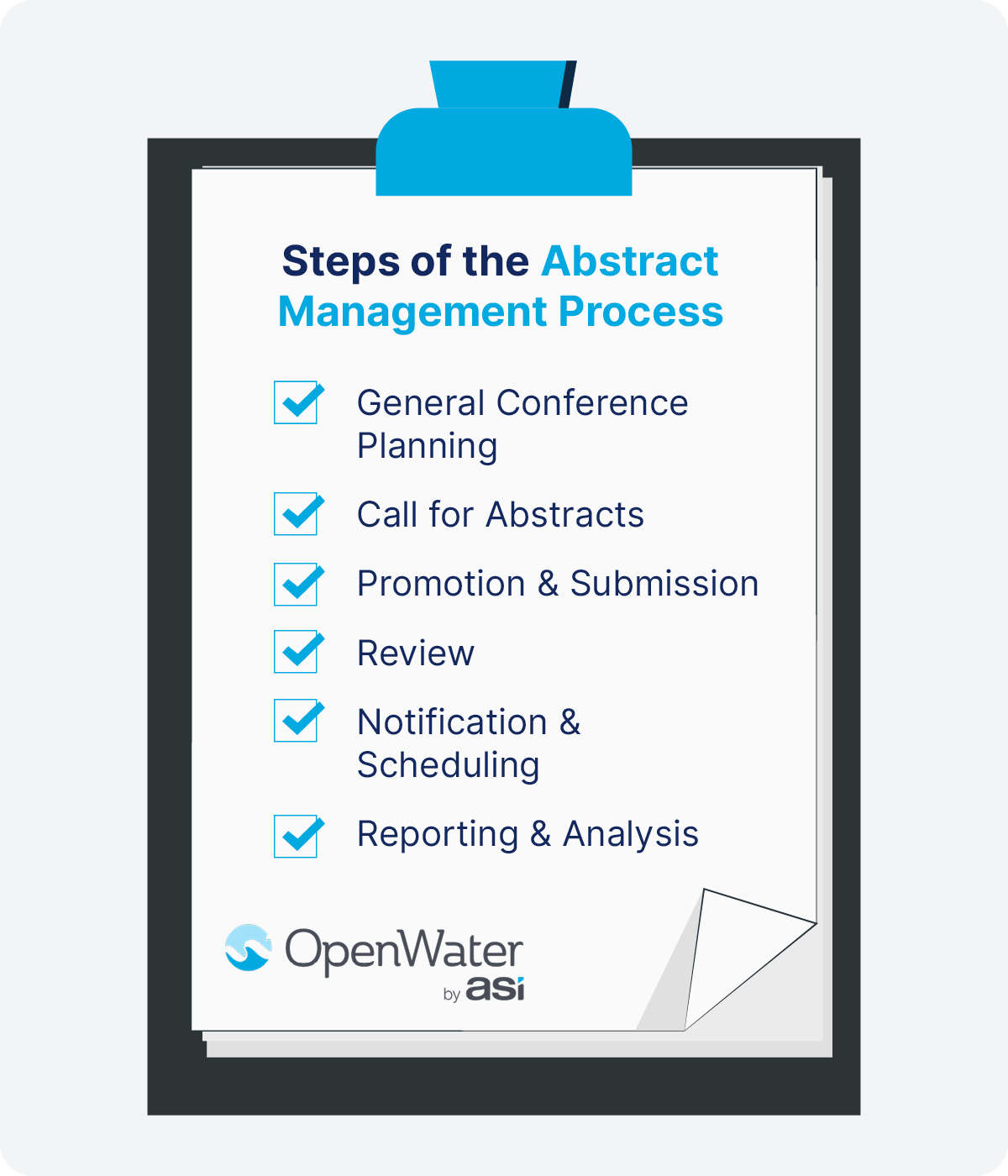
General Conference Planning
Before you start asking for proposals, you’ll need to make several decisions regarding your event that will affect the rest of your abstract management activities. These include:
- The date and length of your conference. This is the first step in determining which and how many potential speakers will apply, since the dates will align better with some people’s schedules than others.
- Your event’s overall format—in-person, virtual, or hybrid—and location. This will also help narrow the list of potential applicants based on preferences and convenience. For example, virtual conferences tend to attract presenters from a wider geographic area as there is no travel required, but presenting fully online may not appeal to speakers who are used to standing in front of a room or are less tech savvy.
- Overall session numbers. Consider not only how many total presentations you need to fill your event schedule, but also how many speakers you can select on different potential topics to add variety to the program. These factors may affect how competitive the evaluation process is, and therefore, they can influence your judging criteria.
- Types of presentations. Many conferences include a variety of session types to attract presenters and attendees with various interests—keynote speakers, oral presentations, posters, panel discussions, workshops, seminars, and more. This will impact scheduling, promotion, and even review, since you might have different requirements for abstract submissions for different presentation categories.
Ensure your whole team is on the same page about these event details before you hone in on abstract management—it’ll make for a smoother process down the road. Additionally, delegate responsibilities like promotion, judging, and notification to willing staff members or volunteers so they’re ready to go when you need them.
Call for Abstracts
Also known as a call for presentations, papers, or submissions, the call for abstracts provides prospective presenters with all of the necessary information to submit abstracts that are clear and consistent with what you want to see. This resource should include the following elements:
- An overview of the event, including logistical details, audience, and theme.
- Submission guidelines like the deadline, word count, acceptable file types, document formatting notes, and content requirements.
- Presentation types that presenters can choose from and whether abstract requirements differ for each type.
- Review timelines so applicants know when they can expect to hear back from you.
- Event registration deadlines and fees for presenters whose abstracts are approved.
- Contact information in case applicants have questions or concerns for your team.
- Any other terms, conditions, considerations, or rules potential speakers should know about.
Consolidate all of this information into one document that your team can review and revise together before the call goes public and refer back to throughout the rest of the process. Once you finalize this internal resource, reformat it into an external-facing version to share publicly.
Promotion & Submission
Promotion turns your submission guidelines into a true “call” for abstracts. Like with many other communication initiatives, your call for abstracts will be most effective if you take a multi-channel marketing approach, using some or all of the following platforms:
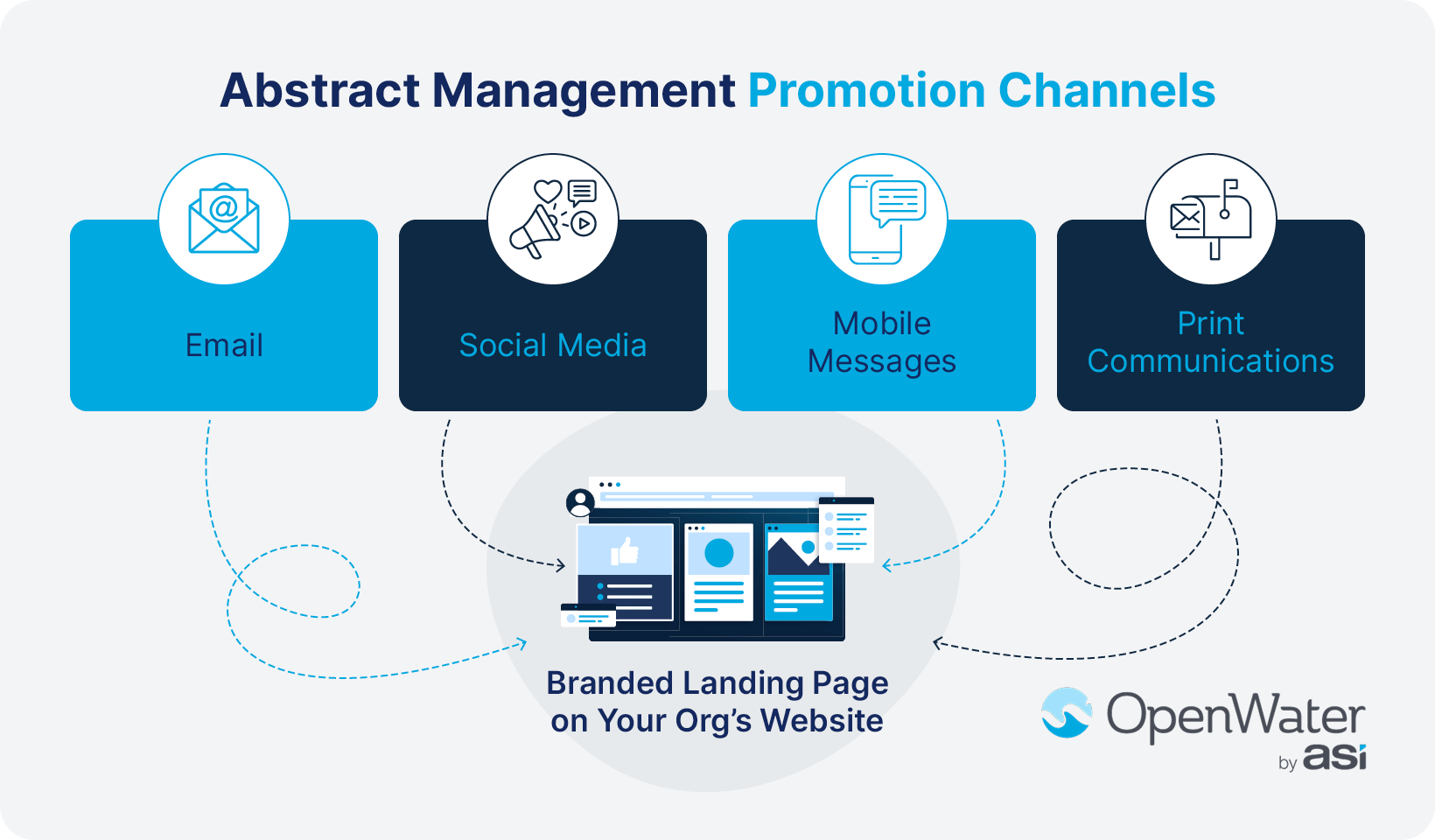
- Emails, including dedicated blasts and mentions in any relevant recurring newsletters your organization sends out.
- Social media posts—LinkedIn and Facebook typically work well for a professional audience, but if you’re targeting younger presenters like undergraduate students, you might also promote your call for abstracts on Instagram or even TikTok.
- Mobile messages, if your organization utilizes segmented text messaging or a member engagement app to communicate with prospective speakers.
- Print communications, such as mailers and flyers, which are still useful for reaching some audiences offline, even though you should keep all submissions online.
In each of your promotional messages, include a link (or QR code in print materials) to a branded landing page on your organization’s website that lays out your entire call for abstracts, since you may not be able to fit every detail into a brief text message or caption. This page should also have a submission portal to make it easy for applicants to send in their proposals as soon as they’re ready.
Review
Once submissions close, it’s time for your judges to review all of the abstracts you’ve received. This part of the process will vary greatly from organization to organization, depending on how many submissions you receive and how many you can accept. You might have one or multiple rounds of review, varying numbers of judges, and different reviewers assigned to presentation formats or topics based on their experience.
No matter how you structure this process, the key is consistency. Use the same rubrics for similar abstracts, store all reviews in one place, and train judges in best practices for fair and honest review before they get started. While you won’t be able to completely eliminate subjectivity from abstract judging, being as consistent as possible will help you identify the best presenters for your event and minimize the impact of personal biases on the results.
Notification & Scheduling
After judging finishes, you should have your finalized list of presenters. Your next set of tasks will alternate between communication and scheduling activities as follows:
- Notify applicants of their abstract’s status by your set deadline so they aren’t left wondering where they stand. Let those who were approved know when they can expect to find out additional information about their presentations. Be sensitive to those who were rejected and encourage them to attend the event anyway.
- Create a schedule by assigning each presenter a time and location to speak at the conference. If a single session includes multiple presenters (e.g., a poster session or block of oral presentations where speakers present one after another in the same room), group similar topics together. However, if sessions will run concurrently, try not to schedule two presentations that appeal to the same audience at the same time so attendees can go to both.
- Follow up with presenters to let them know when they’re presenting and what other next steps they need to take—registering for the event, paying fees, submitting presentation materials, etc.
- Publish your schedule on your event website so it’s visible to potential attendees and incorporate it into your marketing materials to help participants plan which sessions they want to attend in advance.
The more diverse your audience’s interests are, the more complicated scheduling becomes. Sort approved abstracts into topical categories, which could be based on your association members’ professional specialties, areas of study at a university, or other subject matter criteria. This way, you get an idea of which attendees might be interested in each presentation and schedule sessions in such a way that everyone can attend as many sessions as they want and stay busy throughout the whole conference.
Reporting & Analysis
As you implement a new or improved abstract management system, collect data throughout the process. That way, after your event, you can analyze what went well and where you could still improve going forward.
Some abstract management data points to track include:
- Number of abstracts submitted and approved
- Reasons for rejecting abstracts (too many of the same type of presentation, not following directions, etc.)
- Form abandonment rates (i.e., how many people started the submission process but didn’t finish)
- Impressions and click-through rates for various promotional materials
- Average scores from each judge
- Attendance at each conference session
- Participant and presenter satisfaction ratings collected via post-event surveys
Store all of this information in one place, and use dashboards and graphs to visualize it in a way that’s easy for your team to understand and interpret. This way, you’ll have a comprehensive reference point as you plan your next event and put together future calls for abstracts.
How Software Can Help With Abstract Management
If your association or higher ed institution already has an abstract management system, you probably rely on spreadsheets for most of your tracking needs. Most online platforms begin and end with abstract collection, so you have to create separate procedures for review, data tracking, and communication—which is how this process becomes inefficient and various aspects slip through the cracks.
OpenWater stands out from other abstract management tools because it consolidates every step of the process in one user-friendly solution. Here are just a few of the features that set our software apart:
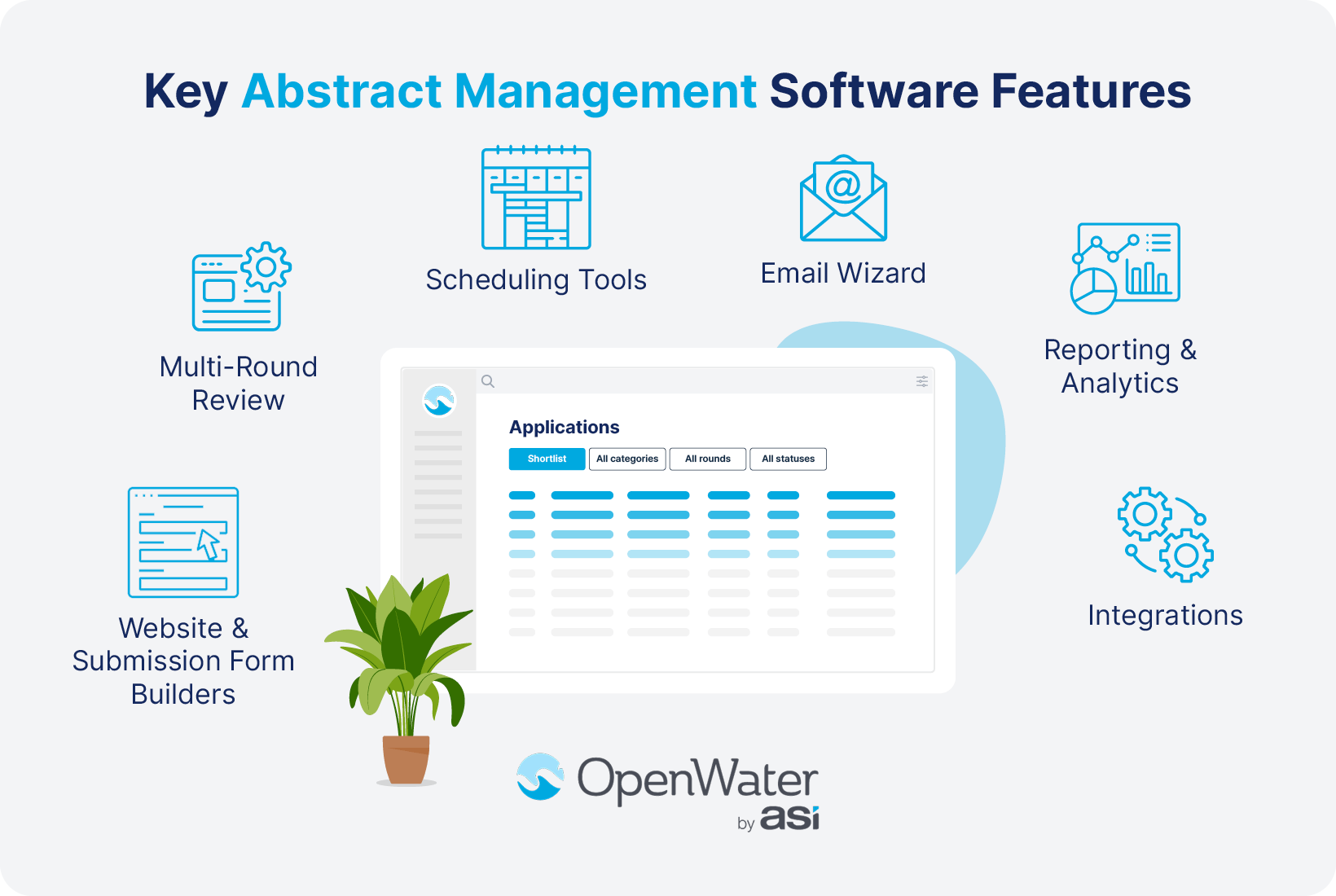
- Beginner-friendly abstract website and submission form builders that allow you to share instructions and collect abstracts in a branded interface with no coding required.
- Efficient multi-round review—when judges log in, they can see and score all of their assigned submissions in one place.
- Comprehensive scheduling tools, including an internal session builder and an external event calendar, to streamline planning for your team and attendees.
- A built-in Email Wizard where you can create templates for common abstract-related messages and send them to their target audience with just a few clicks.
- Reporting and analytics capabilities for easy tracking and evaluation at every stage of the management process.
- Integrations with many popular association and higher education software solutions, such as iMIS, Salesforce, and Higher Logic, to ensure seamless data transfers.
OpenWater can also help you streamline many other essential functions at your organization, including managing awards, grants, scholarships, and fellowships. No matter your submission-related needs, we’ll help you navigate. But don’t just take our word for it—check out our client case studies to see how real associations like yours have leveraged our platform to improve all of these activities!
Wrapping Up: Additional Resources on Application Management
Although planning a conference or similar event involves a lot of moving parts, improving just the one critical aspect of abstract management can save your team a lot of time and hassle. Use the tips above to get started, and consider investing in a fully integrated abstract management solution like OpenWater to streamline your process.
For more information on managing various operations at your association or higher ed institution, check out these resources:
- 5 Member Appreciation Strategies to Maximize Retention. Streamlining abstract collection is just one way you can encourage members to engage with your organization long-term—discover another one, appreciation, in this guide.
- What Is Awards Management? Everything You Need to Know. Explore the similarities and differences between abstract management and a related application-based process, awards management.
- Powerful Abstract Software for Conference & Event Planning. Dive deeper into the specific features and benefits of OpenWater’s abstract management solution, tailor-made for and trusted by organizations like yours.
